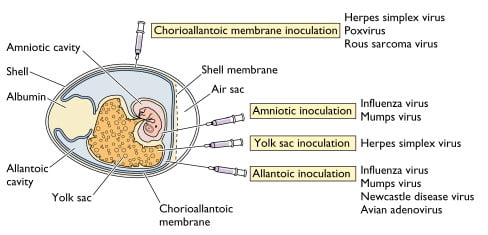Cultivation of Viruses
As viruses are obligate intra-cellular parasite and they need host for their growth and survival. They dependent on host for their DNA replication, protein synthesis and multiplication. Hence, viruses cannot be grown like bacteria or other microorganisms on nutrient media. To grow or cultivate bacterial, plant and animal viruses, we need living cells either in the form of bacteria, animal, embryos, tissue or cells. The aim of cultivating viruses is as follows-
- To discover and understand their structures.
- To learn about their molecular processes.
- To understand and establish the relationship between virus and host.
- To develop strategies for protecting the host.
Host for Cultivating Viruses-
- Embryo (Fertilized egg) –
- 6 to 8 days fertilized chicken egg is used for virus cultivation.
- Before virus inoculation, the egg surface need to be sterilized (as bacteria or other such microbes may cause contamination).
- In order to inoculate the virus, a small pore is made in the shell through which the viral suspension is inoculated.
- The pore is sealed with gelatin or paraffin.
- The inoculated egg is incubated under optimum conditions.
- The fertilized egg provides different sites like chorioallantoic membrane or allantoic cavity for cultivating viruses and the site may be specific to viral species and the inoculation need to be done at appropriate and favorable site.

Advantages –
- The method is cheap
- The fertilized eggs are readily available
- Provide optimum environment for viral growth.
- It does not need skilled labor.
- The fertilized eggs does not have active immune system and hence viral growth is not suppressed.
- Animal Inoculation –
- The animal host is used for those viruses which are difficult to grow on cell, tissue or fertilized eggs.
- The most commonly used animal hosts are mice, rabbits, monkeys, guinea pigs etc. Out of these, mice is most commonly used.
- While inoculating virus in animal host, its age and immune system need to be considered.
- For inoculation, different routes like intracerebral, subcutaneous, intraperitonealor intranasal are used; the selection of route depends on viral species.
Advantages –
- The animal provides optimum envrionment for viral growth and multiplication.
- Animal host are useful to conduct studies on antibodies production against the virus.
- They are also useful for developing daignosis tests.
Disadvantage-
- The animal host immune system may interfere and try to inhibit virus growth.
- It needs animal house and high tech lab conditions and hence it is costly.
- It needs skilled labor.
- Issues related to animal cruelty.
- Cell and Tissue inoculation –
- In Biotechnology, the animal cells are grown In-vitro condition.
- Such In-vitro cell or tissue culture can be used to culture viruses.
- These cells and tissues are grown under required nutritional and physical optimum conditions.
- To protect from bacterial or fungal contamination cells and tissue culture media are also supplemented with antibiotics.
- When monolayer cells or tissue are inoculated with virus and then incubated.
- The virus carry out protein synthesis, DNA replication, multiplies and burst the host cells, releasing the virions. Such localized bursting or lysis of cells are called as plaques.
- The living and dead cells or cells of tissue can be distinguished by different staining techniques.
Advantages:
- It is affordable than Animal host.
- No ethical or animal welfare issue.
- No interfarence of host immune system.
- The spectrum for cultivating virus on cells and tissue culture is broad.
Disadvantage:
- It needs technically skilled labor
- Bacterial Inoculation
- To conduct studies on bacteriophage, they can be grown in bacterial agar plate culture or bacterial broth culture.
- When virus are grown on lawn of bacterial culture media, the virus uses host machinery to reproduce and cause bacterial cell lysis releasing the virions. Such bursting of bacterial cells cause plaque formation or clearing of bacterial lawn.
- When virus are inoculated and incubated in bacterial turbid broth culture, the virus cultivation causes clearing of turbidity.
Advantages –
- The cultivation method is cheap and affordable.
- The cultivation method may help us to develop strategies to inhibit bacterial pathogens using viruses.
- Plant inoculation –
- The plant viruses can be grown in whole plant, plant tissue culture or protoplast culture.
- To cultivate virus in whole plant, the cell wall of leaf cells are abraded and allowing virus to come in contact with plasma membrane and infecting the host. After the incbuation time, necrotic lession or loss of pigmentation may be observed.
- The culturing virus in plant tissue culture is similar to animal tissue culture. Where the plant cells are grown in optimum conditions. After the incubation, the multiplication and release of virions causes plaques formation.
Advantages-
- Cultivation of virus in plant allow us to study the virus and plant host interaction.
- Such studies help us to build strategy to protect the crops.
Purification of Viruses:-
First of all, why is virus purification is needed?. The main reason behind isolation or purification of virus is to study the virus structure, reproduction and other aspects of their biology. There are four most widely used techniques.
- Differential and Density Gradient Centrifugation –
- An aqueous suspension of cell components and viruses is made by disrupting the infected cells in a buffer.
- Viruses can then be isolated by differential centrifugation; to separate the particles of different sizes, suspension is centrifuged at various speeds.
- With the help of gradient centrifugation, viruses can be purified based on their size and density.
- Precipitation of Viruses –
- Many proteins are purified through precipitation with concentrated ammonium sulfate.
- As the capsid of virus is a protein coat, viruses can also be purified with the same method.
- Viruses require specific concentration of ammonium sulfate to be precipitated.
- Initially the concentration of ammonium sulfate is set just below the precipitation concentration of viruses to remove the precipitated contaminants.
- After removing the precipitated contaminants more ammonium sulfate is added and the precipitated viruses are collected by centrifugation.
- Denaturation of contaminants –
- Generally, viruses are less easily denatured than many normal cell constituents.
- In this method contaminants are denatured and precipitated with heat or a change in pH to purify viruses.
- Solvent treatment with organic solvents like butanol and chloroform is also used to purify some viruses.
- Enzymatic digestion of cell constituents –
Cellular proteins and nucleic acids can be removed from many virus preparations through enzymatic degradation because viruses are more resistant from the attack of nucleases and proteases than free nucleic acids and proteins.
Virus Assay –
There are two methods to determine the quantity of viruses in a sample.
- By counting particle numbers – In this method virus particles can be counted directly with the electron microscope or the most popular indirect method of counting virus particles is the heme agglutination assay.
- By measurement of the infectious unit concentration – to analyze the virus number based on its ineffectivity i.e. second method, number of infected cells are counted. Although most normal virions are potentially ineffective, many will not infect the host cell because they do not contact the proper surface site. It depends on the nature of the virion and experimental conditions. In this method there are 2 techniques –
- Plaque Assay
In this technique dilution of bacterial or animal viruses are played out with appropriate host cells but the number of viruses are either kept lesser or same as host cells. Now plaque arise from the host cell layer, each plaque is assumed to be arise from a single virus particle. Therefore count of plaque gives the number of infectious virions or plaque – forming unit (PFU).
2. End point Method –
In this technique organisms or cell cultures are inoculated with serial dilutions of a virus suspension. In this the smallest amount of virus needed to cause effect on the 50% of the host cells is determined by either infectious dose (ID 50) or lethal dose (LD 50).
Classification of Viruses:
The classification of virus is not similar to prkaryotic and eukaryotic classification because we are still not aware about its origin. There classification of viruses is based on following strategies-
- Host (Plant, animal or bacterial)
- Genetic material (DNA or RNA/ Single or double stranded).
- Capsid symmetry
- Size of the virion
- Shape of the virion
- Immunogenic properties
- Number of capsomeres proteins
- Site of DNA replication in host cell
- Diseases and symptoms caused
- Genomic map or sequence.
- Process of virion release
References –
- Willey, J. M., Sherwood, L., Woolverton, C. J., Prescott, L. M., & Willey, J. M. (2011). Prescott’s microbiology. New York: McGraw-Hill.
- https://microbenotes.com/virus-cultivation-purposes-and-methods/
- https://microbiologyinfo.com/techniques-of-virus-cultivation/
- http://www.janatamhvcha.org/uploaded_files/METHODS_OF_CULTIVATION_OF_VIRUSES-converted_Dr_Wankar.pdf



One thought on “Viruses – Cultivation, Purification, Assays & Classification”